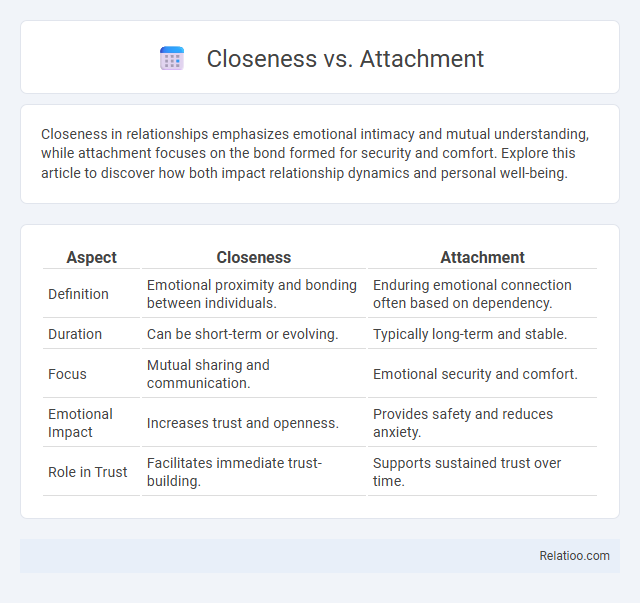Closeness in relationships emphasizes emotional intimacy and mutual understanding, while attachment focuses on the bond formed for security and comfort. Explore this article to discover how both impact relationship dynamics and personal well-being.
Table of Comparison
| Aspect | Closeness | Attachment |
|---|---|---|
| Definition | Emotional proximity and bonding between individuals. | Enduring emotional connection often based on dependency. |
| Duration | Can be short-term or evolving. | Typically long-term and stable. |
| Focus | Mutual sharing and communication. | Emotional security and comfort. |
| Emotional Impact | Increases trust and openness. | Provides safety and reduces anxiety. |
| Role in Trust | Facilitates immediate trust-building. | Supports sustained trust over time. |
Understanding Closeness and Attachment
Understanding closeness involves recognizing the emotional intimacy and trust developed in relationships, while attachment refers to the deep, often subconscious bond formed primarily during early life experiences with caregivers. You experience closeness through shared vulnerability and mutual support, which strengthens relationship quality and emotional connection. Differentiating these concepts helps in fostering healthier bonds by addressing both immediate emotional closeness and underlying attachment patterns.
Key Differences Between Closeness and Attachment
Closeness refers to the mutual sense of intimacy and connection shared between individuals, characterized by open communication and emotional support. Attachment is a deeper psychological bond often formed in early life, influencing behavior and emotional regulation, typically rooted in caregiving relationships. Key differences include that closeness is a dynamic, reciprocal experience that can develop and change over time, whereas attachment is a relatively stable, internalized pattern impacting long-term relational expectations.
Psychological Foundations of Closeness
Psychological foundations of closeness center on emotional intimacy, trust, and mutual understanding between individuals, forming the core of meaningful relationships. Closeness differs from attachment, which is rooted in early developmental bonds and influences your long-term emotional security and behavioral patterns. While attachment often shapes your predispositions, closeness evolves through ongoing interactions and shared experiences that deepen relational satisfaction.
The Science Behind Attachment
The science behind attachment reveals distinct emotional bonds characterized by security, trust, and comfort, which differ from general closeness or casual relationships. Attachment theory highlights how early experiences with caregivers shape your ability to form deep, lasting connections that influence emotional well-being and behavior. Understanding these differences is essential for fostering healthy relationships and emotional resilience.
Emotional Dynamics in Closeness vs Attachment
Emotional dynamics in closeness versus attachment reveal distinct psychological processes: closeness involves mutual understanding, warmth, and emotional intimacy that foster a secure bond, while attachment is characterized by dependency and the need for security rooted in past experiences. Your emotional well-being in close relationships depends on balancing healthy closeness, which encourages autonomy and support, versus attachment patterns that may trigger anxiety or avoidance. Fostering awareness of these emotional dynamics enhances relationship satisfaction and personal growth.
Impact on Relationships: Closeness vs Attachment
Closeness in relationships fosters mutual trust and emotional intimacy, enhancing your ability to connect deeply and support each other. Attachment, often rooted in early experiences, can influence dependency levels and affect relationship stability by shaping how individuals respond to intimacy and separation. Balancing closeness and attachment is crucial for healthy relationships, ensuring emotional bonds that promote security without fostering unhealthy reliance.
Building Healthy Closeness
Building healthy closeness involves fostering emotional intimacy and trust while respecting personal boundaries to avoid unhealthy attachment patterns. Closeness is characterized by mutual understanding and support, whereas attachment may lead to dependency if not managed properly. Your relationships thrive when you balance emotional connection with autonomy, promoting growth and well-being for both partners.
Navigating Secure and Insecure Attachments
Navigating secure and insecure attachments requires understanding the nuanced differences between closeness, attachment, and intimacy. Closeness refers to the emotional proximity you feel with someone, while attachment involves the underlying bond shaped by early experiences and patterns, influencing how you connect and respond in relationships. Recognizing your attachment style helps you foster secure bonds and manage feelings of insecurity or avoidance effectively.
Closeness and Attachment Across Life Stages
Closeness and attachment are fundamental relational dynamics that evolve throughout life stages, influencing emotional bonds and interpersonal security. Closeness reflects the subjective feeling of intimacy and connectedness with others, while attachment refers to the deep, enduring emotional bond formed early in life and shaped by caregiving experiences. Your ability to maintain healthy closeness and attachment patterns supports mental well-being and adaptive relationships from childhood through adulthood.
Improving Emotional Bonds: Strategies and Tips
Improving emotional bonds involves enhancing closeness, attachment, and trust through consistent communication, active listening, and shared experiences. Building closeness requires expressing vulnerability and empathy to deepen mutual understanding, while attachment focuses on creating a secure and reliable connection through emotional support and responsiveness. Prioritizing these strategies fosters stronger, more resilient relationships that withstand challenges and promote long-term emotional well-being.

Infographic: Closeness vs Attachment
 relatioo.com
relatioo.com